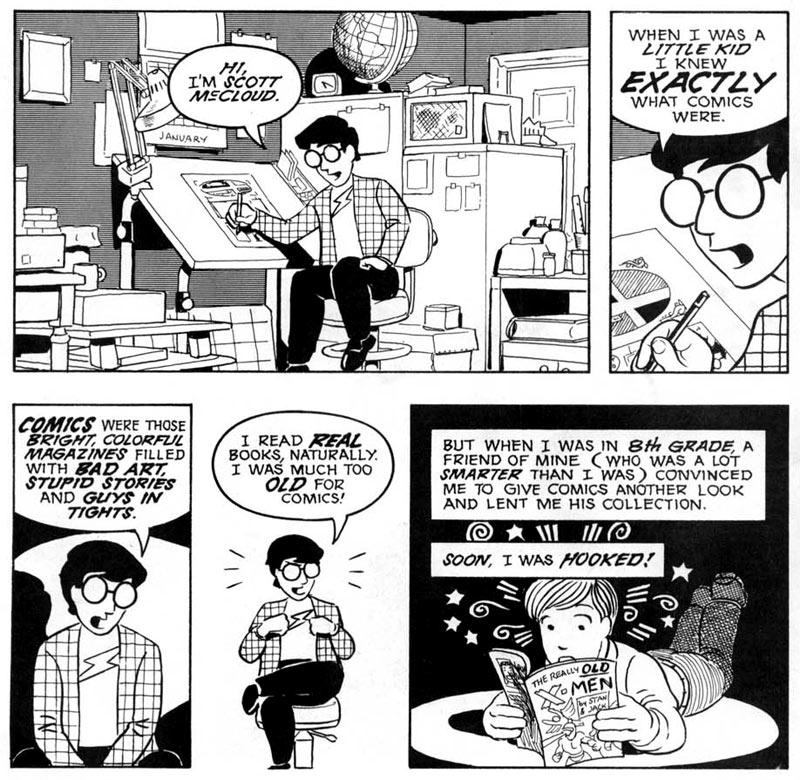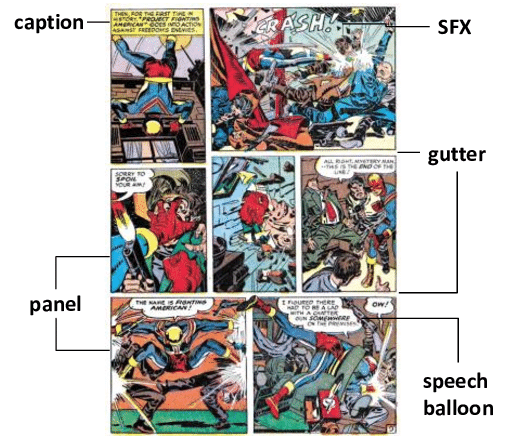Comics
Comics (generally referring to comic books and comic strips) are a popular form of visual storytelling that combines still images and text.
What are comics?
McCloud (1993) defines comics as “juxtaposed pictorial and other images in deliberate sequence, intended to convey information and/or to produce an aesthetic response in the viewer” (20). As in other storytelling mediums like picturebooks, comics’ multimodality and their specific synergy between verbal and image text are defining characteristics. The term comics is sometimes used interchangeably with cartoon, sequential art, and graphic fiction (also graphic novels) and it encompasses an incredibly varied body of work. Even though comics have a varied audience and adults consume them very often, comics play an important part in Children's and Young Adults Literature.

Comic illustration from Scott McCloud’s book Understanding Comics: The Invisible Art (1993) where he explains comic theory in comic format.
Modern comic books emerged at the turn of the 19th century and evolved in different ways in Europe, America and Japan. The appreciation for the storytelling abilities of comics, however, was even more remarkable in that Japanese manga gained reputation both for profitable sales and diversity of genres (Barbosa et al., 2013). In the 1940s, and while superheroes intended for kids and teens initially dominated the market, adult science fiction, fantasy, mystery, and crime comics skyrocketed in popularity once they were introduced (Brenner, 2010).
Cartoon explaining the concept of comics (Bennet, 2016, p.2).
Comic strips are generally short, multi paneled comics that, traditionally, mostly appeared in newspapers. As a narrative form that uses a sequence of panels containing signs and images combined with texts, one defining characteristic of comics is that the reader perceives time spatially. This is achieved thanks to the use of panels and gutters. In a standard comics page, a panel is a moment of the narration including image and/or text, typically framed in a rectangle shape and the gutter is the space between them. These have an important role in the reading flow. The texts are in the form of speech balloons, captions, and onomatopoeic words for sound effects (SFX). The drawing technique used in comics is called cartooning (McCloud, 1993).

Elements of the comics.
References:
Barbosa, S., Ciarlini, A., Feijó, B., Furtado, A., Pozzer, C. & Soares de Lima, E. (2013). Non-branching Interactive Comics. 8253. 230-245.
Bennet, M. (2016). Comics Terms. Comics Workshop Prep Booklet. Marek Bennet blog.
Brenner, R. (2010). ‘Comics and Graphic Novels’. In Coats, K., Enciso, P., Jenkins, C. & Wolf, S. (Eds.). (2010). Handbook of Research on Children's and Young Adult Literature (1st ed.). Routledge.
McCloud, S. (1993). Understanding Comics: The Invisible Art. Kitchen Sink Press